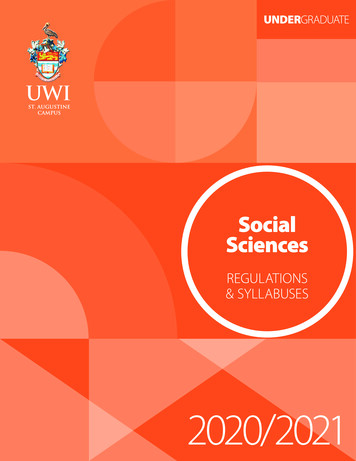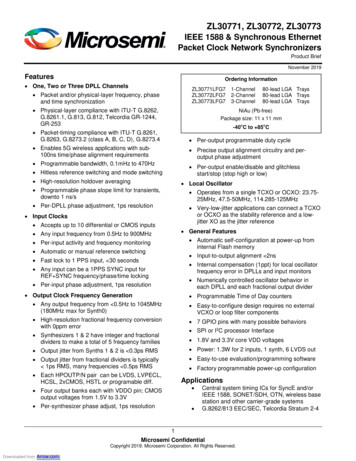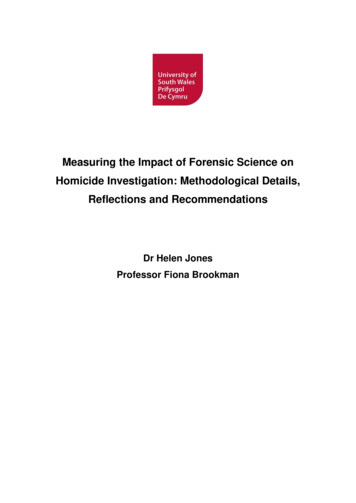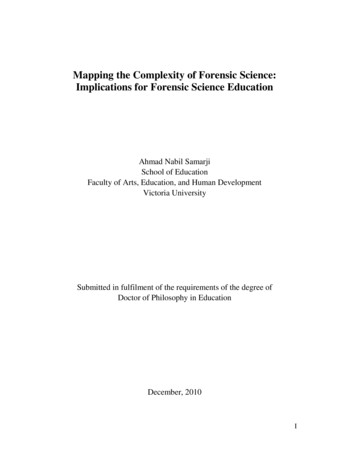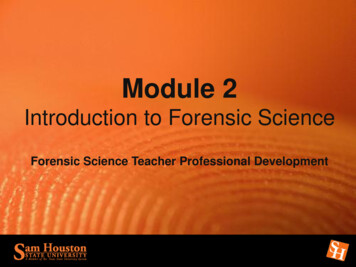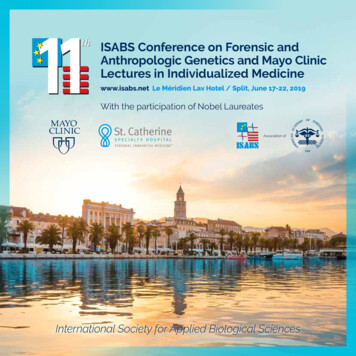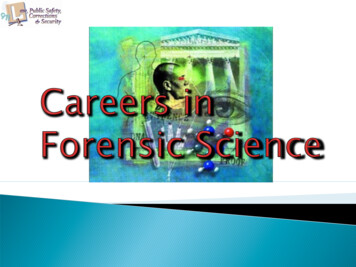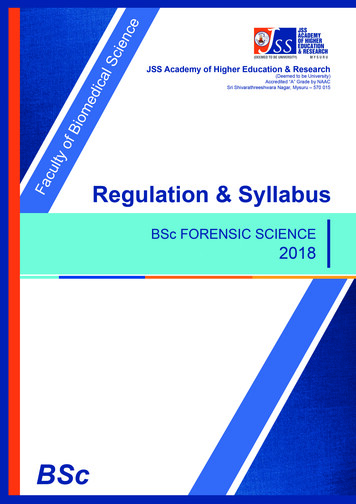
Transcription
1
BSc FORENSIC SCIENCEREGULATIONSCourses offered in Allied Health Sciences1. Bachelor of Science in Medical Laboratory Technology [B.Sc. (MLT)]2. Bachelor of Science in Anesthesia & Operation Theatre Technology [B.Sc.(AOTT)]3. Bachelor of Science in Renal Dialysis Technology [B.Sc. (RDT)]4. Bachelor of Science in Respiratory Care Technology [B.Sc. (RCT)]5. Bachelor of Science in Medical Imaging Technology [B.Sc. (MIT)]6. Bachelor of Science in Cardiac Care Technology [B.Sc. (CCT)]7. Bachelor of Science in Perfusion Technology [B.Sc. (PT)]8. Bachelor of Science in Emergency Medicine Technology [B.Sc. (EMT)].9. Bachelor of Science in Physician Assistant [B.Sc. (P A)]10.Bachelor of Science in Optometry [B.Sc. (optometry)]11.Bachelor of science in Forensic Science (B.Sc. ( Forensic Science))GOALS:1. B. Sc. Forensic Science programme aims to develop the skills necessary totake part in a forensic investigation by providing experience of examiningforensic evidence and case studies.2. It exposes students to the appropriate information related to forensicscience in the broad areas of criminal investigation, laws in relation to it,scientific practical techniques involved so that they can acquire skills necessary to carry out independent work in the respective field.OBJECTIVES:The programme aims to create graduates who will1. Become professionals equipped with the knowledge and skills necessary totake part in a forensic investigation.2. Work and communicate effectively in inter-disciplinary environment, eitherindependently or in a team, and demonstrate leadership qualities.3. Will engage in life-long learning and professional development throughself-study, continuing education or professional and doctoral level studies.1. Eligibility for admissionA candidate seeking admission to the Bachelor of Science Degree in Allied HealthSciences [a) to h) above], shall have studied English as one of the principal subjects and shall have passed2a.Two year Pre-University examination or equivalent as recognized byJSS Academy of Higher Education and Research (JSSAHER), Mysore withPhysics, Chemistry and Biology as principal subjects of study.ORb.Pre-degree course from a recognized University considered asequivalent by JSSAHER, (two years after ten years of schooling) withPhysics, Chemistry and Biology as principal subjects of study.ORc.Any equivalent examination recognized by the JSSAHER for the abovepurpose, with Physics, Chemistry and Biology as principal subjects of study.OR
d.Vocational higher secondary education course conducted by VocationalHigher Secondary Education, Government of Kerala with five subjectsincluding Physics, Chemistry, Biology and English in addition tovocational subjects conducted, considered equivalent to ‘plus – two’[10 2] examinations of Government of Karnataka Pre University Course.ORe.Two years diploma from a recognized Government Board in a subjectfor which the candidate desires to enroll in the respective Allied HealthSciences course and shall have passed ‘plus two’ [10 2] with Physics,Chemistry and Biology, as principle subjects.ORf.Three years diploma from a recognized Government Board in a subjectfor which the candidate desires to enroll in the respective Allied HealthSciences course, with Physics, Chemistry and Biology as principal subjectsduring the tenure of the course.ORg.Senior secondary course with Physics, Chemistry and Biology as principalsubject of study equivalent to class XII, of open school education systemof the central government and state government approved institutions.h.In case of B.Sc. Imaging Technology the candidate shall have passedPre-University or equivalent examination with Physics, Chemistry,Biology and Mathematics, as principal subjects of study.2. Duration of the courseDuration shall be for a period of Six Semesters (three years).3. Medium of instructionThe medium of instruction and examination shall be English.4. AttendanceCandidates should have attended at least 75% of the total number of classesconducted in an academic year, from the date of commencement of the semester to the last working day, as notified by the JSSAHER, in each of the subjectsprescribed for that year (theory & practicals) to be eligible to appear for the JSSAHER examinations. Candidates lacking prescribed percentage of attendance in anysubject shall not be eligible to appear for the JSSAHER examination in that subject.5. Internal assessment (IA)There shall be a minimum of two Internal assessment examinations in theory and practical of each core subject spread over evenly in each semester. Theaverage marks of the two IA examinations shall be submitted to the JSSAHER atleast 15 days before the commencement of the JSSAHER examination. The JSSAHER shall have access to the records of IA examinations. Candidates have tosecure 35% marks in the IA theory and practical jointly in each subject to becomeeligible to appear for the Deemed to be University examination. The marks ofthe IA examinations must be displayed on the notice board of the respectivedepartments within a fortnight from the date of IA examination. If a candidate isabsent for any of the IA examinations due to genuine and satisfactory reasons,such a candidate may be given a re-examination, within a fortnight.3
6. Subject and hours of teaching for theory and practicalsThe number of hours of teaching theory and practical, course wise in each semester are shown in table I, II, III, IV, V and VI.There are two compulsory core subjects in each semester. Language, Allied andSkill enhancement subjects are mandatory for all courses. Candidates shall selectone elective subject each in fifth and sixth semester from the list mentioned in thetable VII.Table I: Distribution of teaching hours in First Semester 20Physiology 60420Basic 6Category SubjectsCreditsCore - 1Core - 2Core - 3LanguageEnglish30-1LanguageKannada30-2Total18 2 2Credits2--3022--302Table II: Distribution of teaching hours in Second Semester yPharmacologyIntroduction toForensicSciencePsychologyCore -5Core - 6Allied - 1Allied - 2TotalCredits418 2 2TheoryPracticalTotal TotalCreditsCreditshourshourshours credits604202806604202806604202806302--302302--302
Table III: Distribution of teaching hours in Third Semester subjectsCategory SubjectsCore - 7Core - 8Core - matoglyphicsCriminalLawCrimeand SocietyComputerapplicationEnvironment science tal Totalhours 18 2 2Table IV: Distribution of teaching hours in Fourth Semester subjectsCategory SubjectsCriminalisticsTechnologicalMethodsCore - 11in Forensic ScienceQuestionedCore - 12DocumentsBiostatSkillics andEnhance- Researchment-2methodologyConstiAllied-4tution ofIndiaTotal18 2Credits 2Core - 10TheoryhoursCredits Practicals 202806302--302302--3025
Table V: Distribution of teaching hours in fifth Semester subjectsCategory SubjectsCore - 13Core - 14Core - 15Elective 1Allied - 5TotalCreditsTheoryhoursForensicChemis60try andPhysicsForensic60MedicineForensicBiology & 60Serology30Pharmacologyand Pharmaceuti- 30cal DrugAnalysisCredits 80642028062--3022--30218 2 2Table VI: Distribution of teaching hours in sixth Semester subjectsCategory SubjectsCore - 16Core - 17Core - llisticsElective 2Allied - 6DigitalForensicsTotalCredits18 2 26TheoryhoursModalityCredits Postings 4202806604202806302--302302--302
Table VII: Elective SubjectsElective SubjectsFifth SemesterAccident InvestigationEconomic OffencesSixth SemesterDNA TypingIntroduction to biometryExtension ActivityThe following extension activities shall be provided for the ability enhancement ofthe candidates, to provide better services. The certificate shall be provided by theoffering departments.Extension Activity CoursesSmall Project/dataAll coursesAnalysisSemesterOffering departmentsVForensic Medicine7. End Semester Examinationa.JSSAHER examinations - The JSSAHER shall conduct examination for thecore subjects at the end of each semester. The candidates, who satisfythe requirement of attendance and internal assessment, shall be eligibleto appear for the JSSAHER examination. The head of the institution shallverify the same before forwarding the applications to the JSSDU withinstipulated time along with the prescribed fee.b.Non- JSSAHER Examinations: Examination for Languages, Allied subjects,Skill enhancement and Elective subjects shall be conducted by the collegeand the marks obtained shall be submitted to the JSSAHER along with theIA marks of the core subjects at least 15 days before the commencementof the JSSAHER examination. The marks of non-core subjects shall beincorporated in the marks card issued by the JSSAHER.c.The candidate must have passed all the previous subjects (Core/Language/Skill enhancement/ Allied/elective), to appear for the sixth semesterJSSAHER examination.8. Scheme of Examination:Distribution of subjects and marks for each semester theory and practical examinations are shown in the Table – VIII, IX, X, XI, XII and XIII.Table VIII: Distribution of Subjects and marks for First Semester theoryand practical examinationPracticalCategory SubjectsTheoryIAUENUE Total IAUENUETotalCore - 1Anatomy3070-1001040-50Core - 2Physiology3070-1001040-507
Core - 3Language-1Language-2Basic a--5050----Table IX : Distribution of Subjects and marks for Second Semester theoryand practical examinationCategory SubjectsCore-4Core -5Core – 6Allied - 1Allied - on toForensic 050Table X: Distribution of Subjects and marks for Third Semester theory andpractical examinationCategory SubjectsCore – 7Core – 8Core – 9ForensicDermatoglyphicsCriminalLawCrime nvironment science andHealth--5050----8
Table XI: Distribution of Subjects and marks for Fourth Semester theoryand practical examinationCategoryCore - 10Core - 11Core - sCriminalisticsTechnologicalMethods inForensic ScienceQuestionedDocumentsBiostaticsand ResearchmethodologyConstitution 040-501001040-50-1001040-50-5050--5050----Table XII: Distribution of Subjects and marks for Fifth Semester theoryand practical examinationCategoryCore - 13Core - 14Core - 15Elective y 30and PhysicsForensic30MedicineForensicBiology &30SerologyPharmacology andPharmaceuticalDrug 040-5070-1001040-50-5050-----5050----9
Table XIII: Distribution of Subjects and marks for Sixth Semester theoryand practical examinationCategoryCore - 16Core - 17Core - 18SubjectsIATheoryUE NUE Total IAPracticalUE NUE --5050-Digital Forensics --5050-Forensic AnthropologyForensic ToxicologyForensic BallisticsElective 2Allied-6---Question paper pattern for end of Semester Deemed to be University theory examinations (70 marks)IIIIIILong Answers (Answer 2 out of 3)Short Essay (Answer 7 out of 9)Answer (Answer all 5)Total 2 x 10 207 x 5 355 x 3 1570 marksQuestion paper pattern for end of Semester Non-Deemed to be Universitytheory examinations (50 marks)IIIIIILong Answers (Answer 1 out of 3)Short Essay (Answer 5 out of 7)Answer (Answer all 5)Total 1 x 10 105 x 5 255 x 3 1550 marks9. Examinersa. Appointment of ExaminersExaminers shall be appointed by the JSSAHER to conduct the end Semester JSSAHER examinations, from the panel of examiners approved by the Board of Studies.For Practical examinations, there shall be one external examiner and one internalexaminer. Theory paper shall be valued by both the examiners.b. Qualification and Experience of ExaminersFor question paper setting and external examiner: Post graduation in the respective field with five years of teaching experience.For Internal examiners: Post graduation in the respective field with three years ofteaching experience.10. Criteria for passCore Subjects: Candidates are declared to have passed in a subject, if they secure40% of marks in JSSAHER examination and internal assessment added together.Theory & practical shall be considered as separate subjects. If a candidate passesin practical examination but fails in theory paper, such candidate is exempted from10
reappearing for practical but shall have to appear in the subsequent examinationfor the theory paper in which the candidate has failed OR vice versa.Language papers, allied papers, skill enhancement and elective papers: The minimum prescribed marks for a pass shall be 35% of the maximum marks prescribedfor a subject.11. Grading of performancesa. Letter grades and grade points allocationsBased on the performances, each student shall be awarded a final letter gradeat the end of the year for each course. The letter grades and their correspondinggrade points are given in Table – XIV.Table – XIV: Letter grades and grade points equivalent to percentage ofmarks and performancesOABCDEGradePoint1098765Less than 40F0FailAbsentAB0FailPercentage of Marks obtained Letter Grade90.0080.0070.0060.0050.0040.00– 100– 89.99– 79.99– 69.99– 59.99- actoryAverageA candidate who remains absent for any end of year examination shall be assigned a letter grade of AB and a corresponding grade point of zero. He/she shouldreappear for the said evaluation/examination in due course.b. The Semester Grade Point Average (SGPA)The performance of a student in a semester is indicated by a number called ‘Semester Grade Point Average’ (SGPA). The SGPA is the weighted average of thegrade points obtained in all the courses by the student during the semester. For example, if a student takes five courses (Theory/Practical) in a semester with creditsC1, C2, C3, C4 and C5 and the student’s grade points in these courses are G1, G2,G3, G4 and G5, respectively, and then students’ SGPA is equal to:C1G1 C2G2 C3G3 C4G4 C5G5SGPA 1 C2 C3 C4 C5The SGPA is calculated to two decimal points. It should be noted that, the SGPAfor any semester shall take into consideration the F and ABS grade awarded in thatsemester. For example if a learner has a F or ABS grade in course 4, the SGPA shallthen be computed as:11
C1G1 C2G2 C3G3 C4* ZERO C5G5SGPA -------C1 C2 C3 C4 C5c. Cumulative Grade Point Average (CGPA)The CGPA is calculated with the SGPA of all the VIII semesters to two decimal pointsand is indicated in final grade report card/final transcript showing the grades of allVIII semesters and their courses. The CGPA shall reflect the failed status in caseof F grade(s), till the course(s) is/are passed. When the course(s) is/are passed byobtaining a pass grade on subsequent examination(s) the CGPA shall only reflectthe new grade and not the fail grades earned earlier. The CGPA is calculated as:C1S1 C2S2 C3S3 C4S4 C5S5 C6S6 C7S7 C8S8CGPA ----------------------C1 C2 C3 C4 C5 C6 C7 C8where C1, C2, C3, . is the total number of credits for semester I,II,III, . and S1, S2,S3, .is the SGPA of semester I,II,III, . .12. Declaration of classThe class shall be awarded on the basis of CGPA as follows:First Class with DistinctionFirst ClassSecond ClassPass Class CGPACGPACGPACGPAof. 7.50 and aboveof 6.00 to 7.49of 5.00 to 5.99of 4.00 to 4.9913. Carry overA candidate should pass all the subjects (core/language/skill enhancement/ allied/elective) of first semester, to enter into the third semester. Similarly, secondsemester subjects should be cleared before entering fourth semester and thirdsemester subjects should be cleared before entering fifth semester. However, thecandidate must have passed all the previous subjects (core/language/skill enhancement/ allied/elective) to appear for the sixth semester Deemed to be University examination14. Award of Ranks/MedalsRanks and Medals shall be awarded on the basis of final CGPA. However, candidates who fail in one or more subject during the course shall not be eligible foraward of ranks.15. Award of degreeA candidate who has passed in all the subjects (core/language/allied/skill enhancement/elective papers) of all the semesters shall be eligible for award of degree.16. Revaluation and Re-totaling of answer papersThere is no provision for revaluation of the answer papers in any examination.However, the candidates can apply for re-totaling by paying prescribed fee.17. Maximum duration for completion of courseA candidate shall complete the course within six years from date of admission,failing, which candidate shall re-register for the course.12
I SEMESTERCore-1 AnatomyOBJECTIVES:AT THE END OF THE COURSE THE STUDENT SHOULD BE ABLE TO: Describe the structure, composition and functions of the organ systems ofhuman body. Describe how the organ systems function and interrelate. Learn basic technical terminology and language associated with anatomy.LEARNING OBJECTIVES: SKILLS Use the process of prosection to investigate anatomical structure. Use the microscope to learn anatomical or histological structure. Learn how to study, interpret and care for anatomical specimens.CONTENTSTheory:Unit I: Organization of the Human Body12hrsIntroduction to the human bodyDefinition and subdivisions of anatomyAnatomical position and terminologyCell – Definition of a cell, shapes and sizes of cells-Parts of a cell–cell membranes, cytoplasm, sub cellular organelles.Cell Division–Definition and main events in different stages of mitosis and meiosis.Tissues – Tissues of the body-Definition and types of tissues-Characteristics, functions and locations of different types of tissues-Epithelial tissue – definition, classification with examples-Glands- classification with examplesUnit II : Locomotion and Support1. Cartilage – Types with examples12hrs2. Skeletal systemSkeleton – Definition, axial and appendicular skeleton with names and number ofbones, Types of bones. Marking of bones. Functions of bones.Development (typesand ossification) and growth of bone.Name, location and general features of thebones of the body.Joints – Definition and types of joints with examples. Axes and kind of movementspossible. Name, location, type, bones forming, ligaments, movements possibleand the muscles producing such movements of the joints of the body.3. Muscular systemParts of the Skeletal muscle. Definition of origin and insertion. Classification ofmuscular tissue Compartment muscles of upper limb , lower limb , sternocleidomastoidUnit III : Maintenance of the Human Body12hrs1. Cardio-vascular systemTypes and general structure of blood vessels. Structure and types of arteries andveins. Structure of capillaries. Shape, size, location, coverings, external and inter-13
nal features of heart. Structure of heart wall, conducting system and Blood supply of the heart. The systemic arteries and veins. Name, location, branches andmain-distribution of major arteries and veins.2. Lymphatic systemLymph, lymphatic vessels, name, location and features of the lymphoid organs.3. Respiratory systemNames of organs of respiration, Location and features of nose, pharynx, larynx,trachea, bronchi, lungs and pleura.4. Digestive systemNames of organs of digestion.Location and features of mouth, pharynx, esophagus, stomach, small and large intestines. Location and features of salivary glands,pancreas, liver and gall bladderUNIT IV.1.Urinary system and Reproductive system12hrs1. Names of urinary organs, location and features of kidney, ureter, urinarybladder and urethra.Names of male and female organs of reproduction. Location and features of scrotum, testis, epididymis, vas deferens, seminal vesicle, ejaculatory duct,prostate gland, penis and spermatic cord.Location and features of uterus and its supports, uterine tube, ovary and mammary gland.2. DevelopmentGametes, period of gestation, gametogenesis, structure of sperm and ovum,growth of ovarian follicles, events of 1st, 2nd and 3rd weeks of development, folding of embryo. Derivatives of germ layers.placentaUnit V : Control Systems of the Body12hrs1. Nervous systemSub-divisions of the nervous systemBrain – Sub-divisions, location external features and internal structure of medullaoblongata, pons, mid-brain, cerebellum and cerebrum.Spinal cord – Location, extent, spinal segments, external features and internalstructure.Location and features of thalamus and hypothalamus.Locations and subdivisions of basal ganglia, Meninges and spaces around them.Name and location of ventricles of brain and circulation of cerebrospinal fluid.Blood supply of the brain and spinal cord. Cranial nerves2. Sense organsLocation and features of the nose, tongue, eye, ear and skin3. Endocrine systemNames of the endocrine glands.Location and features of pituitary, thyroid, parathyroid, suprarenal, pancreas, ovaries and testes.Names of hormones produced byeach gland.14
Practical :1. Demonstration of parts of microscope and its uses2. Demonstration of skeleton and joint3. Demonstration of deltoid and gluteus maximus ,Cubital fossa4. Demonstration of heart and its blood supply, demonstration of majorarteries of upper limb and lower limb, histology of cardiac muscle andhistology of vessels5. Demonstration of location and parts of lungs , histology of trachea andlungs6. Demonstration of location of stomach, small and large intestines. Locationand features of pancreas, liver and gall bladder7. Demonstration of location and features of kidney, ureter, urinary bladderand urethra. Histology of urinary system except urethra8. Demonstration of location of male and female reproductive organs9. Demonstration of brain and spinal cord10.Histology of cornea and retinaPRACTICAL EXAMINATION PATTERN40 MARKS1. GROSS ANATOMY- Discussion of any one specimen 10 MarksDisscusion of specimen of Cardiovascular system, Respiratory System ,Gastrointestinal system , Urinary system, Reproductive system2. Spotters - Cardiovascular system, Respiratory System , Gastrointestinalsystem , Urinary system, Reproductive system – 10x2 20 Marks3. Histology discussion of any one demonstrated slide 10 MarksRecommended books: Ross and Wilson: Anatomy and Physiology in Health and illness Understanding Human anatomy and physiology , William davis(p) MCGraw Hill Essentials of Human embryology .Bhatnagar, Orient Blackswanpvt ltd Anatomy for BSc Nursing by RenuChauhan. Arichal publishing company2012 1st edition Hand book of anatomy BD ChaurasiaReference books:1. B D Chaurasia: Regional Anatomy. Vol I, II,III 6th edition15
I SEMESTERCore- 2 PhysiologyObjectives- At the end of the semester students should be able to describe1. Blood cell counts2. Nerve and muscle functions3. Cardiac functions4. Pulmonary functions5. Renal functions6. The actions of various hormones7. Functions of Central nervous system and special sensesContents:TheoryUNIT -I General physiology and Blood12 hrsGENERAL PHYSIOLOGY (2 Hrs) ORGANIZATION OF THE CELL AND ITS FUNCTION,HOMEOSTASIS TRANSPORT ACROSS CELL MEMBRANE MEMBRANE POTENTIALS - RESTING MEMBRANE POTENTIAL & ACTIONPOTENTIAL BODY FLUID COMPARTMENTS - NORMAL VALUESBlood(10 Hrs) Introduction: composition and function of blood. Red blood cells: erythropoiesis, stages of - differentiation, function, count,physiological variation. Structure, function, concentration, physiological variation, methods of estimation of haemoglobin. white blood cells: production, function, count. platelets: origin, normal count, morphology & functions. plasma proteins: types, functions haemostasis: definition, normal haemostasis, clotting factors, mechanismof clotting, disorders of clotting. blood groups: abo system, rh system.blood grouping & typing, cross matching.rh system: rh factor, rh incompatibility. blood transfusion: indication.transfusion reactions. anticoagulants: classification, examples and uses. anaemias: morphological and etiological classification, -blood indices: ci, mch, mcv, mchc. erythrocyte sedimentation rate (esr) and packed cell volume, normalvalues.unit –ii digestive system & respiratory system12hrsdigestive system (4hrs) physiological anatomy of gastro intestinal tract, functions of digestive system. salivary glands: structure and functions, deglutition: stages and regulation. stomach: structure and functions.gastric secretion: composition functionregulation of gastric juice secretion. Pancreas : structure, function, composition of pancreatic juice functions of liver. Bile secretion, composition, function. Jaundice: types. functions of gall bladder.16
small intestine: functions, digestion, absorption,movements.large intestine: functions, movements defecationRespiratory system (8 hrs) functions of respiratory system, physiological anatomy of respiratory system, respiratory tract, respiratory muscles. mechanism of normal and rigorous respiration, forces opposing and favoring expansion of the lungs. intra pulmonary & intrapleural pressure. surface tension, recoil tendency of the thoracic cage and lungs . transport of respiratory gases: transport of oxygen & carbon dioxide, oxyhaemoglobin dissociation curve , factors affecting it. lung volumes and capacities –normal values regulation of respiration: mechanisms of regulation,nervous and chemicalregulation, respiratory centre, applied physiology : hypoxia, cyanosis, dyspnoea, apnoea.Unit –iii Cardiovascular And Endocrine System12hrscardiovascular system (7hrs) heart: physiological anatomy, nerve supply. properties of cardiac muscle, cardiac cycle: conducting system of heart,origin and spread of cardiac impulse electrocardiogram (ecg) waves and normal duration.recording cardiac cycle:phases and volume changes normal heart sounds, areas of auscultation. pulse: jugular, radial pulse, cardiac output : definitions of stroke volume, cardiac index, factors affectingit.measurement of cardiac output . general principles of circulation blood pressure: definition, normal value, clinical measurement of bloodpressure, hypotension, hypertension. factors affecting it and regulation physiological variations & regulation of heart rate. coronary circulation. shockEndocrine system (5hrs) classification of endocrine glands & definition of hormone. pituitary hormones: anterior and posterior pituitary hormones, secretion,functions thyroid gland: physiological anatomy, hormone secreted, physiologicalfunction, regulation, secretion, disorders ( hypo and hyper secretion ofhormone). adrenal cortex: physiological anatomy. cortical hormones, functions andregulation. adrenal medulla: hormones, regulation and secretion.functions of adrenaline and nor adrenaline. hormones of pancreas.insulin: secretion, regulation, function and action.diabetes mellitus: regulation of blood glucose level. parathyroid gland: function, action, regulation of secretion of parathyroidhormone Calcitonin:17
UNIT –IV Excretory system and Reproductive system12 hrsExcretory System(8Hrs) Functional anatomy of kidney juxta glomerular apparatus: structure and function. glomerular filtration tubular function(reabsorption and secretion) micturition, innervation of bladder, cystometrogram. artificial kidney, renal function tests skin and body temperatureReproductive system(4Hrs) Male reproductive system: functions of testes, spermatogenesis: Endocrine functions of testes -Female reproductive system: oestrogen, progesteron ,menstrual cycle: ovulation, physiological changes during pregnancy,pregnancy tests. Lactation: composition of milk, factors controlling lactation.UNIT –V Muscle nerve physiology, Nervous system and Special senses12hrsMuscle nerve physiology (3Hrs) classification and properties of neuron and neuroglia .classification ofnerve fibers Classification of muscle, structure of skeletal muscle, Neuromuscular junction. Transmission across nmj Excitation contraction coupling. muscle tone, fatigue, rigor mortisNervous system (5Hrs) organisation of nervous system Synapse: structure, types, properties. Receptors: definition, classification, properties. Sensations-pain organization Spinal cord. Ascending tracts, descending tracts. Reflex : definition reflex arc, clinical classification of reflexes : Babinski’s sign. hypothalamus- functions Cerebral cortex lobes -functions, cerebellum- functions Basal ganglia: functions. Cerebro Spinal Fluid(CSF) : formation, circulation & reabsorption . composition and functions. Lumbar puncture. Autonomic Nervous System: Sympathetic and parasympathetic distributionSpecial senses(4Hrs) Vision: structure of eye, function of different parts.Structure of retina. visual pathway, errors of refraction Hearing: structure and functions of ear. Taste : taste buds and taste pathway. olfaction : receptors, pathway.Practicals (20 hrs)1. Haemoglobinometry.2. Haemocytometry3. total leucocyte count.18
4.5.6.7.8.Total Red blood cell count.Determination of blood groups.differential WBC count.Determination of clotting time, bleeding time.Erythrocyte sedimentation rate (ESR). Determination of packed cell Volume, Calculation of Blood indices: CI, MCH, MCV, MCHC.9. Blood pressure recording.10. spirometery,
10.Bachelor of Science in Optometry [B.Sc. (optometry)] 11.Bachelor of science in Forensic Science (B.Sc. ( Forensic Science)) GOALS: 1. B. Sc. Forensic Science programme aims to develop the skills necessary to take part in a forensic investigation by providing experience of examining forensic evidence and case studies. 2.
